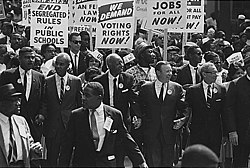A demonstration is the public display of the common opinion of an activist group, which often deal with politics, economics, and society, or the issues related to it. Thus, such an opinion is demonstrated to be public and significant by gathering in a crowd, usually at a symbolic place or date, associated with that opinion. Demonstrations can be used to show an opinion in protest or as a criticism of a public issue or a perceived grievance or social injustice. First Amendment of the United States Constitution specifically allows demonstrations and the freedom of assembly as part of a measure to facilitate the redress of such grievances.


A demonstration is usually considered more successful the more people participate. A growing trend in the United States has been the implementation of "free speech zones," a fenced-in area which is often far-removed from the event which is being protested; critics of free-speech zones argue that they go against the First Amendment of the United States Constitution by their very nature and that they lessen the impact the demonstration might have otherwise had.
Some demonstrations and protests can turn, at least partially, into riots or violence against objects such as automobiles and businesses, bystanders and the police. These acts of destruction against private property -- which are not thought to be acts of "violence" by some, since they do not hurt people -- are targeted toward major corporations and chain stores, and rarely affect independently-owned businesses. Police often use non-lethal force weapons, such as tasers, rubber bullets and pepper spray against the crowd; it is believed by some that they use agents provocateurs to rile the crowd, thereby justifying the use of violence against demonstrators.